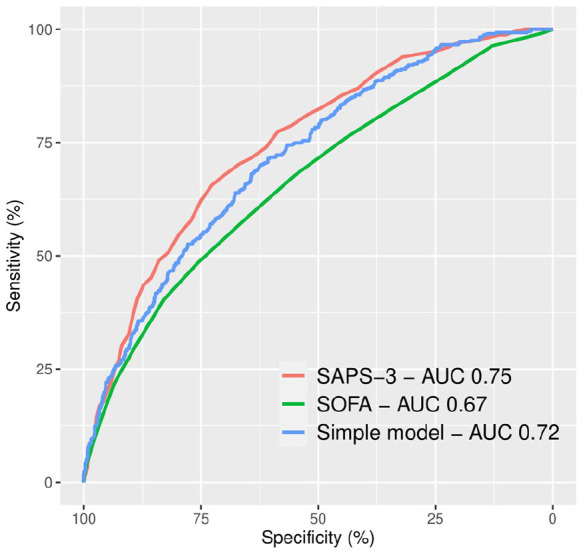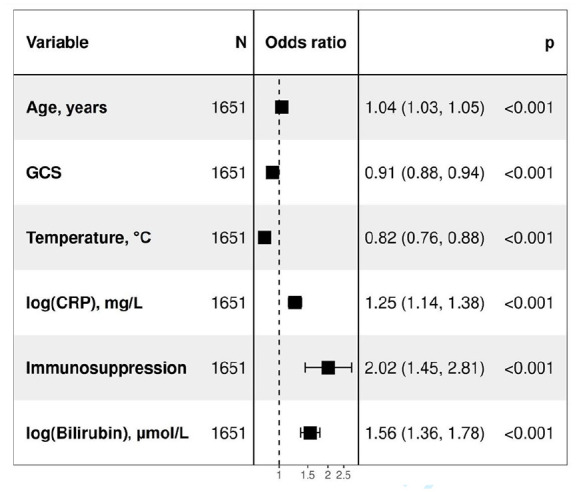A simple mortality prediction model for sepsis patients in intensive care.
IF 2.1
Q3 CRITICAL CARE MEDICINE
Journal of the Intensive Care Society
Pub Date : 2023-11-01
Epub Date: 2023-02-01
DOI:10.1177/17511437221149572
引用次数: 1
Abstract
Background: Sepsis is common in the intensive care unit (ICU). Two of the ICU’s most widely used mortality prediction models are the Simplified Acute Physiology Score 3 (SAPS-3) and the Sequential Organ Failure Assessment (SOFA) score. We aimed to assess the mortality prediction performance of SAPS-3 and SOFA upon ICU admission for sepsis and find a simpler mortality prediction model for these patients to be used in clinical practice and when conducting studies. Methods: A retrospective study of adult patients fulfilling the Sepsis-3 criteria admitted to four general ICUs was performed. A simple prognostic model was created using backward stepwise multivariate logistic regression. The area under the curve (AUC) of SAPS-3, SOFA and the simple model was assessed. Results: One thousand nine hundred eighty four admissions were included. A simple six-parameter model consisting of age, immunosuppression, Glasgow Coma Scale, body temperature, C-reactive protein and bilirubin had an AUC of 0.72 (95% confidence interval (CI) 0.69–0.75) for 30-day mortality, which was non-inferior to SAPS-3 (AUC 0.75, 95% CI 0.72–0.77) (p = 0.071). SOFA had an AUC of 0.67 (95% CI 0.64–0.70) and was inferior to SAPS-3 (p < 0.001) and our simple model (p = 0.0019). Conclusion: SAPS-3 has a lower prognostic value in sepsis than in the general ICU population. SOFA performs less well than SAPS-3. Our simple six-parameter model predicts mortality just as well as SAPS-3 upon ICU admission for sepsis, allowing the design of simple studies and performance monitoring.



重症监护中败血症患者的简单死亡率预测模型。
背景:脓毒症在重症监护室很常见。ICU最广泛使用的两个死亡率预测模型是简化急性生理学评分3(SAPS-3)和序贯器官衰竭评估(SOFA)评分。我们旨在评估SAPS-3和SOFA在败血症入住ICU时的死亡率预测性能,并为这些患者找到一个更简单的死亡率预测模型,用于临床实践和进行研究。方法:对四个普通ICU中符合Sepsis-3标准的成年患者进行回顾性研究。使用后向逐步多变量逻辑回归建立了一个简单的预后模型。评估SAPS-3、SOFA和简单模型的曲线下面积(AUC)。结果:包括一千九百八十四名住院患者。由年龄、免疫抑制、格拉斯哥昏迷量表、体温、C反应蛋白和胆红素组成的简单六参数模型30天死亡率的AUC为0.72(95%置信区间(CI)0.69-0.75),不劣于SAPS-3(AUC 0.75,95%CI 0.72-0.77)(p = 0.071)。SOFA的AUC为0.67(95%CI 0.64-0.70),低于SAPS-3(p p = 0.0019)。结论:SAPS-3对败血症的预后价值低于普通ICU人群。SOFA的性能不如SAPS-3。我们的简单六参数模型预测败血症入住ICU时的死亡率与SAPS-3一样好,允许设计简单的研究和性能监测。
本文章由计算机程序翻译,如有差异,请以英文原文为准。
求助全文
约1分钟内获得全文
求助全文
来源期刊

Journal of the Intensive Care Society
Nursing-Critical Care Nursing
CiteScore
4.40
自引率
0.00%
发文量
45
期刊介绍:
The Journal of the Intensive Care Society (JICS) is an international, peer-reviewed journal that strives to disseminate clinically and scientifically relevant peer-reviewed research, evaluation, experience and opinion to all staff working in the field of intensive care medicine. Our aim is to inform clinicians on the provision of best practice and provide direction for innovative scientific research in what is one of the broadest and most multi-disciplinary healthcare specialties. While original articles and systematic reviews lie at the heart of the Journal, we also value and recognise the need for opinion articles, case reports and correspondence to guide clinically and scientifically important areas in which conclusive evidence is lacking. The style of the Journal is based on its founding mission statement to ‘instruct, inform and entertain by encompassing the best aspects of both tabloid and broadsheet''.
 求助内容:
求助内容: 应助结果提醒方式:
应助结果提醒方式:


